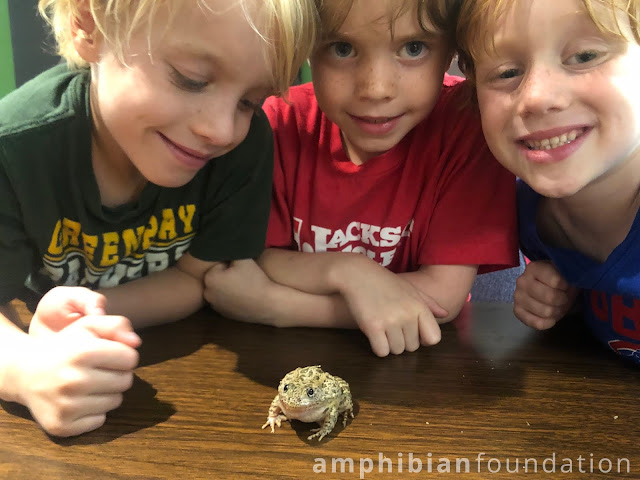In 2019, the Memphis Zoo and the Amphibian Foundation began collaborating on a project to further conserve the
Gopher Frog,
Rana (
Lithobates)
capito, through a
Memphis Zoo Conservation Action Network (CAN) Grant. The grant was aimed at supporting the expansion of both the
in situ and
ex situ research initiatives developing at the Amphibian Foundation, and we are extremely grateful for the zoo's support in this project.
In situ Goals
 |
| Gopher Frog summit @ AF 2018 |
Amphibian Foundation staff serve on the Gopher Frog Task Team, which is an ad hoc interstate group of agencies and institutions dedicated to conserving this imperiled species throughout its range. The team targets populations in need of conservation and augmentation, as well as identifying areas in need of restoration to support wild populations of the species. We are happy for the opportunity to contribute in this talented and passionate group.
In a task team meeting, we identified
Alligator Creek Wildlife Management Area (ACWMA) as a survey site for the Amphibian Foundation, given its relative proximity to Atlanta and the records of Gopher Frogs occupying portions of the WMA. The Memphis Zoo CAN Grant not only supported our research at Alligator Creek, but allowed us to initiate a
Community Science project — bringing city-folks who are interested in contributing to amphibian conservation to the area to survey for Gopher Frogs. These sampling events consist of larval (tadpole) surveys with dipnets, and upland surveys of adults, which can be detected in
Gopher Tortoise burrows using a Burrow Camera. All of the equipment needed for these surveys were provided by the CAN grant. Through the AF mailing list and social media posts, we recruited people interested in joining us for our field surveys.
 |
| The Burrow Camera provided by the CAN grant allows us to survey Gopher Tortoise burrows for Gopher Frogs. |
 |
| Volunteer 'Community Scientists' surveying one of the wetlands at Alligator Creek |
 |
| Javiera dipnets a Little Grass Frog |
 |
| Sarah inspects a frog eggs mass |
 |
| Gopher Frog eggs (pictured here) are easily confused with Southern Leopard Frogs, which breed at similar times of year. |
Our task is to confirm the presence of Gopher Frog on the WMA, and identify breeding populations.
 |
| Anthony surveying a large ephemeral wetland at Alligator Creek |
 |
| A volunteer inspecting amphibian eggs. |
Ex situ Goals
Back at the Amphibian Foundation, we are focused on two population augmentation programs to bolster wild populations of imperiled Gopher Frogs. The first one is a head-start program (AKA assisted metamorphosis). Head-start in this instance means that eggs are collected from the wild and reared through metamorphosis — then released as small froglets— either right back where they came from or translocated to a recipient pond. The second initiative is to establish captive breeding populations of Gopher Frogs, where we will produce eggs at the Foundation that can be translocated in egg, larvae, or froglet stage into recipient wetlands at Georgia Department of Natural Resource's discretion.
 |
| The Amphibian Research & Conservation Center (ARCC): Gopher Frogs and other native imperiled species are housed in mesocosms, or experimentally controllable artificial wetlands. The ARCC is located on the beautiful Blue Heron Nature Preserve, which is a City of Atlanta park and open to the public (dawn-dusk) |
 |
| Gopher Frogs in pseudo-situ housed in outdoor mesocosms |
 |
| Young adult Gopher Frogs peering out of an artificial burrow in their mesocosm |
 |
| New cattle tanks arrive (thanks to the Memphis Zoo) and are waiting to be set up as head-start aquatic mesocosms |
Anthony rolling out a cattle tank to the ARCC to be set up as a mesocosm.
 |
| The additional mesocosms installed at the ARCC thanks to the Memphis Zoo CAN Grant. This brings the total of our artificla wetlands to 33. |
|
 |
| Memphis Zoo researchers Sheila and Kristen collecting Gopher Frog sperm at the ARCC for their cryobanking research. |
Education Goals
 |
| Students in the Amphibian Foundation's Master Herpetologist Program gather around one of the mesocosms at the ARCC |
 |
| Introducing children to Gopher Frogs is one of our favorite things to do. Little by little we are increasing awareness for this imperiled species in the next generation |























Comments
Post a Comment